
|
Twelve Monkeys (1995) (aka
12 Monkeys)
In director Terry Gilliam's non-linear, very complex
and plot-twisting, sci-fi fantasy thriller - it told about time travel,
subjective false memories and multiple realities, unusual efforts
to thwart a devastating global plague, and futile attempts to change
destiny. It was definitely inspired by Chris Marker's French science-fiction
featurette film La Jetée/The Pier (1962, Fr.)), and
there were many referential allusions to Hitchcock's Vertigo
(1958).
On a budget of $29 million, the film grossed $57.1 million (domestic)
and $168.8 million (worldwide).
The film was eventually considered the second
film in a satirical, dystopic-world trilogy (an "Orwellian Triptych"),
including his earlier film Brazil (1985) and
later The Zero Theorem (2013). The tagline for the
film was related to the plot: "The future is history." Time
travel films also featuring movement between the past, present
and future included Terminator 2: Judgment Day (1991) and Looper (2012).
- as the film opened in the future year of 2035 in
Philadelphia, a title card described the current situation, quoting
from a 1990 prediction about a deadly virus that would devastate
Earth in 1996-7:
- "...5 billion people will die from a deadly virus in 1997...
... The survivors will abandon the surface of the planet...
... Once again the animals will rule the world..."
- Excerpts from interview with clinically diagnosed paranoid
schizophrenic. April 12, 1990 - Baltimore County
Hospital.
- after the opening credits, at an airport, a wide-eyed
young boy (Joseph Melito) witnessed a
deadly shooting incident; a gun-carrying long-haired man (wearing
a tropical shirt and white pants) was gunned down
in a long corridor by security police; as he died on the floor,
he raised up his bloody hand to the face of a grieving blonde woman
above him
- [Note: This incident was filmed as an obsessive,
nightmarish dream that haunted the mind of the film's protagonist;
the meaning of the recurring childhood memory was not understood
even though it replayed itself often throughout the film; the paradox
of the film - spoiler - was that the young boy watching the airport
shooting and the long-haired, gunned down victim were the same
person.]
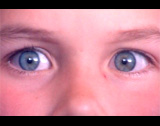
Wide-Eyed Boy Watching a Deadly Shooting Incident
|
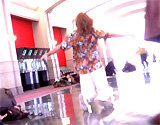
Long-Haired Man Gunned Down by Airport Security Police
|

|

|
|
First Instance - A Young Boy Witnessing Deadly Airport
Shooting; Bloodied Victim Reached His Hand Up to Touch Blonde Haired-Woman
|
- caged in a secured, 8 x 12 jail cell
within a maze-like underground prison, convict-inmate James "Jim" Cole
(Bruce Willis) awoke from the dream
- he was presumably the young boy remembering a past event; it was
implied that he had been selected or "volunteered" from
the other confined inmates for a "first-time probe"; he was
to venture out into the existing, post-apocalyptic world of 2035 -
Earth had now been virus-plagued for about four decades; a horrible
virus had killed 5 billion people in 1996-1997 and forced humanity
to live underground (the surface of the Earth was unliveable due to
poisonous air)
- after suiting up in a transparent protective body
covering (a "body condom"), Cole emerged through a manhole
cover onto the street level of the snow-covered, plague-ridden city
of Philadelphia in the year 2035 that had become overrun with wild
animals; as he was gathering a live insect specimen, he was approached
from behind by a giant growling brown grizzly bear; he spotted a
snow covered graffiti-scrawled sign: "WE DID IT" stamped
with the blood-red insignia of the "12
Monkeys," and he spotted a lion prowling
on an upper building's ledge

|

|

|

|

|

|
|
Cole Emerging Into Plague-Infected City of
Philadelphia in the Year 2035, Overrun with Wild Animals
|
- once he returned underground, he was stripped and
spray-sanitized, quarantined for an unspecified period of time, and
then brought forward to be questioned by a group of white-coated
scientists, still in the year 2035
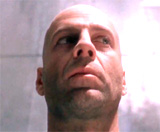
Cole Released From Quarantine
|
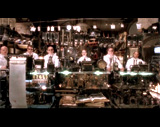
Cole Brought To a Panel of White-Coated Scientists
|
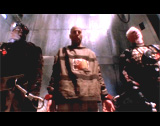
Cole Appearing Before Scientists to be Questioned
|
- Cole's offenses were noted in his past history: "Violence.
Antisocial Six. Repeated violations of the Permanent Emergency Code.
Insolence. Defiance. Disregard of authority. Doing 25 to life";
as his charges were being read, Cole surveyed the room and noticed
two browned, Philadelphia newspaper article clippings, explaining how
a virus had threatened the world in 1996-97; scientist Dr. Leland Goines
(Christopher Plummer) had been quoted as saying "Too Late For
Cure," and as a result, "MILLIONS FEAR END SOON"

|

|
|
A Virus Threatened the World in 1996-1997, Leading
to a Post-Apocalyptic World
|
- after being arm-strapped into
a metal steel chair in an Engineering Room and hoisted about 12 feet
in the air, Cole faced questioning - as a giant "video ball" with
15 multiple screens hovered in front of his face; Cole was offered
to be sent back in time in exchange for being pardoned or receiving
a reduced sentence for his violent and anti-social behavior; a scientist
told Cole that he would "play an important role in
returning the human race to the surface of the Earth"; a female
scientist added that he had been chosen for the mission
because he was observant and due to his mental state: "We want
tough-minded people. Strong, mentally. We've had some misfortunes
with unstable types"
- the next scene was set in the city of Baltimore in
April of 1990 (pre-virus); it was revealed that Cole had been sent
back to observe the past and collect
information, and to obtain a pure sample of the unmutated virus in
1996 so that a cure might be found to prevent the future plague and
ensure humanity's continued existence; however, his first time-travel
journey went completely awry, and he ended
up in Baltimore in 1990 (rather than in 1996)
- the sequence in Baltimore commenced with the introduction
of psychiatrist Dr. Kathryn Railly (Madeleine
Stowe) who was summoned to the County Jail to interview Cole after
he had assaulted five police officers; Detective Franki (Joey Perillo)
described Cole as "totally irrational, totally disoriented...stoned
out of his mind, some kind of psychotic episode"; Cole was found
without an ID wandering around in his underwear, wearing a transparent
raincoat and "screaming about viruses"
- when Dr. Railly questioned Cole, he was agitated and
drooling; she asked - the first of recurring instances: "Have
I seen you someplace?"; he described his mission to gather information (but not to change
the future) - "I'm supposed to be gathering information!...Won't help you. Won't help
anyone. Won't change anything"; Cole marveled at the fresh air
in 1990: "Such wonderful air...Very fresh. No germs"
- due to disorientation and delusions possibly from
the time-travel (represented by canted-angled shots in this and other
scenes), Dr. Railly committed Cole to the Baltimore County Hospital;
as Cole was brought into the County Hospital, the TV in the day
room would play three manic 1940s Tex Avery short cartoons - all
involving animals: Swing
Shift Cinderella (1945), Little 'Tinker (1948), and Who
Killed Who? (1943)
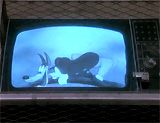
Swing Shift Cinderella (1945)
|
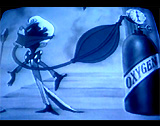
Little 'Tinker (1948)
|
- in the institution, Cole met crazed, and hyperactive,
manic inmate Jeffrey Goines (Brad Pitt), who was instructed by an
orderly to tell Cole about the asylum's rules and lead him around;
as they toured the facility, conspiracy theorist Goines pointed out
patients who were playing various tranquilizing board games that
served as tranquilizing drug dosages: ("They vegetize you");
he also spoke about chemical restraints, and the reasons for not
allowing communication with the outside world; he then expounded
on his anti-corporation and consumerism beliefs while he became more
and more hysterical as he talked: "There's
the television. It's all right there - all right there. Look, listen,
kneel, pray. Commercials! We're not productive anymore. We don't
make things anymore. It's all automated. What are we for then? We're
consumers. Yeah. Okay, okay. Buy a lot of stuff, you're a good citizen.
But if you don't buy a lot of stuff, if you don't, what are you then,
I ask you? What? Mentally ill"

|

|
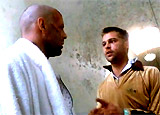
|

|

|

|
|
Animal Activist Jeffrey Goines (Brad Pitt) With
Cole in the Baltimore Mental Asylum
|
- when interviewed by a panel of Baltimore doctors in
1990, Cole attempted to explain the future virus outbreak and plague,
and his related mission: ("Five billion people died in 1996 and 1997.
Almost the entire population of the world. Only about one percent
of us survived...This already happened. I can't save you. Nobody
can. I am simply trying to gather information to help the people
in the present trace the path of the virus"); the stranded time-traveler
Cole was unable to convince the doctors that he was from a far-future
year, and that the virus epidemic started in 1996; he was allowed
to make a telephone call to scientists in the future - who he claimed
could monitor his voice-mail messages - but realized a major problem
after reaching a wrong number: ("This is 1990. I'm supposed to be
leaving messages in 1996. It's not the right number yet"); Dr. Railly
again mentioned: "I have the strangest feeling that I've met you
before" before Cole experienced a second disturbing dream-memory
of the airport shooting

|

|

|

|

|

|
|
Second Instance of a Dream Memory of an Airport Shooting
- A Long-Haired Man With a Flowered Shirt Aimed His Gun at Fleeing
Suitcase-Carrying Suspect with a Yellow Jacket
|
- [Note: Recall the opening title card quote - Cole was the "clinically
diagnosed paranoid schizophrenic" who was interviewed.
It was entirely conceivable that the entire deadly virus scenario
was only a creation or expression of Cole's deep psychosis in order
to mask his own mental condition (another patient termed the condition
as being "mentally divergent").]
- after awakening from his dream in the asylum in the
middle of the night, the psychotic, agitated and delusional Goines
ranted on and on to Cole about how the idea of "germs"
was created to sell more disinfectants; while Goines was disruptively
agitated, Cole caught a spider - and then swallowed it, presumably
- in his distorted mind - to preserve it as a specimen for study, as
he explained later: "I got a specimen, a spider. I didn't have anyplace
to put it, so I ate it"
- Goines went on to explain why he "would be crazy to
escape" from the institution - he claimed: "I am all taken care of"
- due to expectations that he would be rescued by his famous, wealthy
and respected virologist father Dr. Leland Goines: ("Wait'll you
morons find out who I am. My father's gonna be really upset. And
when my father gets upset, the ground shakes! My father is God! I
worship my father!"); the ironic fact was that Jeffrey's embarrassed
father was responsible for having his son institutionalized in the
first place
- the next day, the TV in the day room was playing a
British documentary titled Horizon: The Cruel Choice (1983) about
controversial animal experimentation (on monkeys and rabbits); eccentric,
insane animal activist Jeffrey Goines watched and concurred: "Torture
experiments. We're all monkeys"; Cole pondered: "Maybe the
human race deserves to be wiped out" - it was an extremely crucial
statement; later in the day, a TV travel ad promoted the Florida Keys
as a perfect vacation getaway ("You
can fly to paradise"), before returning to regular programming
- the Marx' Brothers' comedy Monkey Business (1931); Goines
attempted to create a chaotic diversion so that Cole could escape,
but Cole was so disoriented and confused that he was soon apprehended
after a violent struggle with orderlies on a different floor; he was
given a calming sedative, restrained and placed in a cell
- Cole inexplicably disappeared from his cell, followed
by a third instance of Cole's dream of an airport shooting
- due to apparent mixups in 'time travel,' Cole awoke
back where he started - in the present year of 2035 - he was also
in a locked room, with a creepy and raspy voice chastising him: "You
sure f--ked up!"; the
tormenting voice (that called him "Bob") even confirmed
it might be coming from Cole's own brain: "Maybe I'm just in
your head. No way to confirm anything";
after Cole explained he had wrongfully been sent to the year 1990,
the voice asked: "How was it? Good drugs? Lots of pussy? Hey,
Bob, you do the job? You find out the big info? Army of the Twelve
Monkeys?...Science ain't an exact science with these clowns, but, they're
getting better. You're lucky you didn't end up in ancient Egypt." [Note:
Much of the film's strange, raspy-voiced dialogue was presumably
in Cole's own mentally-disturbed head, while living in the year 1990
and paranoically fantasizing about the future virus.]
- again, Cole appeared facing the panel of white-coated
scientists while seated in an elevated chair with the hovering "video
ball" (with multiple screens) in front of him; the panel listened
to a reconstructed taped recording of a message, indicating that
the location of The Freedom for Animals Association had been found
on Second Avenue (in a building with a concrete pig head
over the door)
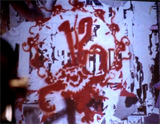
The Insignia of the 12 Monkeys
|
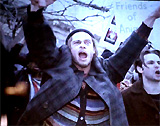
Crazed Animal Activist, Cult Leader and Mental Patient
Jeffrey Goines
|
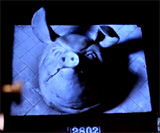
The Concrete Pig Head Above the Location of the Freedom
for Animals Association
|
|
Slide Show Presented to Cole - Confirming His Belief
That the Army of the 12 Monkeys Was Responsible for the Spread of
the Virus
|
- during a slide-show, Cole's
suspicions about crazy cult leader Jeffrey Goines,
who headed the radical, revolutionary and eco-terrorist group known
as "The Army of the 12 Monkeys," were confirmed that he was
most likely the one responsible for the worldwide plague and virus
spread that killed five billion people and made Earth unlivable in 1996
- afterwards, Cole was given another chance
to return to the third quarter of the year 1996 - but this time, he
was again misdirected and briefly sent to October 1917 (WWI battle
of Ypres in France), where during a chemical weapons attack in the
trenches, the nearly-naked Cole encountered his injured cell-mate
(another time-traveling prisoner and volunteer named Jose (Jon Seda))
who was sent to find him and was yelling from a stretcher after being
wounded from shrapnel: ("I
gotta find 'em. Help me. I don't know where I am"); Cole was
also wounded when hit by a bullet in the left leg and was subsequently
hospitalized - but then mysteriously vanished
- in another time-travel trip, Cole ended up at his
original destination - Baltimore in November of 1996, where a museum
lecture was in progress; his psychiatrist Dr. Kathryn Railly was
delivering a speech titled Apocalyptic Visions; she specifically
referred to the use of chemical warfare and mustard gas during the
Great War (WWI), reported by a English-speaking soldier (Jose) on
a stretcher: ("He claimed that he had come from the future, that he was looking for
a pure germ, that would ultimately wipe mankind off the face of the
Earth starting in the year 1996") - she seemed to conflate Jose
with Cole's apocalyptic warnings
- Dr. Railly described how the war-wounded individual
(and others) were suffering from a "self-inflicted
agony" or mental disorder from Greek legend known as the Cassandra
Complex - a case in which a person knew about and was warning others
about future doom - such as a plague-doomsday scenario - but was completely
ignored: ("Cassandra in Greek legend, you recall, was condemned
to know the future but to be disbelieved when she foretold it. Hence
the agony of foreknowledge combined with the impotence to do anything
about it")
- following the lecture, Dr. Railly held a book-signing
for her book The Doomsday Syndrome (containing a picture of
the WWI soldier); at the signing, she spoke with red-haired, pony-tailed
bio-terrorist Dr. Peters (David Morse), Dr. Goines'
lab assistant, who expressed his extremist and alarmist views, similar
to a "Chicken Little" or someone 'crying wolf', about the
environmental crisis caused by human meddling: ("...the planet
cannot survive the excesses of the human race...Proliferation of atomic
devices, uncontrolled breeding habits, pollution of land, sea and air,
the rape of the environment")
- after the event while entering her parked car,
Dr. Railly was kidnapped by Cole - disguised as a thug; he forced
her to drive to Philadelphia, explaining: "That's
where they are, the ones who did it. The Twelve Monkeys"; in
the Oasis Motel, as the TV played a Woody Woodpecker cartoon, "Prehistoric
Super Salesman"(1969)
about a mad scientist and his time-tunnel machine, she was
tied down to a bed; Cole had just experienced his fourth dream-memory;
again, it was of a man being shot from behind as a woman ran toward
him; he identified Dr. Railly as the woman in his recurring dream;
the TV played a newscast about the Baltimore kidnapping of psychiatrist
Dr. Railly by "former mental patient" James Cole
- while proceeding in her car into downtown Philadelphia
to search for the "secret army" of the virus-spreading
Twelve Monkeys, Cole clearly explained to Dr. Railly that his mission
was to track down their cult leader Jeffrey Goines: "I just
have to locate them because they have the virus in its pure form
before it mutates. When I locate them, they'll send a scientist back
here. That scientist will study the virus. Then when he goes back
to the present, he and the rest of his scientists will make a cure";
he cautioned Dr. Railly:
"You won't think I'm crazy when people start dying next month";
Cole became crazed about the coming doomsday when he located red-painted
insignia of the 12 Monkeys on a concrete wall in a slum area of the
city - it portrayed a ring of red plastic monkeys
- a nearby homeless vagrant named Louie (Harry O'Toole)
warned Cole about a tracking device installed in one of his teeth;
when attacked by two thugs -- a would-be black rapist (Chuck Jeffreys)
and another man with a gun (Korchenko), Cole brutally killed both
of them to protect Dr. Railly
- Cole came upon the
headquarters of the FAA (identified by a pig's head above the door)
- the Freedom for Animals Association; inside were three young members:
Fale (Felix Pire), Bee (Matt Ross), and African-American female Teddy
(Lisa Gay Hamilton); Cole tied them up and questioned them, as they
explained that Jeffrey Goines wasn't interested in their peaceful
methods of protest (calling them "ineffectual liberal jerk-offs"),
but instead advocated underground "guerrilla actions" such
as letting loose 100 snakes in the Senate; however, the trio derisively
called Jeffrey Goines "Mr. Big Shot" - who had betrayed
his Army of 12 Monkeys members and capitulated to his famous virologist
father's use of animals in the lab for experimentation purposes

|

|
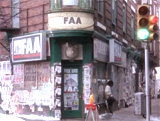
Headquarters of the FAA in Philadelphia
|
|
Vagrant Louie Warning About Tooth Tracking Device
|
- in a Rolodex, Cole located the address of the Goines'
residence (27 Outerbridge Rd.) in Philadelphia; as they drove away
in a stolen car, Dr. Railly became highly skeptical about Cole -
her previous mental patient that she had originally
institutionalized and committed to the Baltimore County Hospital
in 1990: "You're not going to save the world. Okay? You're delusional";
she noticed his bloody, bullet-wounded left leg and urged buying
supplies: ("You need stitches and antibiotics"); she also
pressured him to give himself up
- at an "opulent dinner" event hosted at the luxurious
Goines' residence (with released asylum patient Jeffrey seated in
attendance amongst the well-dressed guests), Dr. Goines delivered
a cautionary speech: ("...the dangers of science are a timeworn threat.
From Prometheus stealin' fire from the gods...to the Cold War era
of the Dr Strangelove terror. But never before...to fear the power
we have at hand"); Cole snuck in with no ID but was able to convince
Security Agents to allow him to speak to Jeffrey
- as they climbed the stairs to
the second floor, Cole told Jeffrey about his mission: ("I just want
access to the pure virus....I need to know where it is and exactly
what it is"); Goines reminded Cole that in the hospital six years
earlier, he had heard Cole off-handedly mention in the TV-room how
a virus could be developed by his famous virologist father that could
wipe out mankind, but save the animals; in effect, Goines
blamed Cole for inspiring him and justifying his animal activism,
but then called Cole a "total nutcase! Completely deranged! Delusional!
Paranoid!"; Goines now vowed that he no longer had any association
with the Army of the Twelve Monkeys ("nature space-case do-gooders"):
"I quit being the rich kid fall guy for a bunch of ineffective fanatics.
So much for your grand plot, asshole"
- as Cole was being ejected
from the property by security agents, he escaped and fled outside
back to his stolen vehicle where he released an upset Dr. Railly
locked up in the trunk; Cole described to her what Goines had told
him: "Jeffrey Goines said that it was my idea about the virus. We
were in the institution. It was all so fuzzy, and the drugs and all.
You think it was my idea? You think maybe I've wiped out the human
race?"; Dr. Railly analyzed his delusion: "You've created something
in your mind....A substitute reality because you don't want to
deal with anything"
- suddenly, Cole disappeared - another instance of time-travel
- during her debriefing with Philly PD Lt. Halperin (Christopher Meloni), Dr.
Railly described Cole's mental state: "He thinks he comes from the
future. He's been living in a meticulously-constructed fantasy world,
and that world is starting to disintegrate. He needs help"
- after another time-journey forward
to the year 2035, Cole was in a hospital bed
surrounded by scientists who confirmed that he had completed his
mission - and that he had been pardoned: ("You connected the Army
of the Twelve Monkeys with a world-famous virologist and his son");
Cole expressed how he doubted his own sanity: ("You're in my mind!
I am insane. And you are my insanity"); again, Cole had a short conversation
with the raspy voice in his head - similar to the voice of the
vagrant with no teeth: ("You sure f--ked up, Bob....You're thinkin'
I don't exist except in your head. I can see that point of view.
But you could still talk to me, couldn't ya?")
- Lt. Halperin phoned Dr. Railly to inform her that
the bullet she had removed from Cole's leg was an "antique" - fired
sometime prior to the 1920s; Dr. Railly reached for her book and
saw the cropped picture of a wounded man (Jose) on a stretcher; then
she went searching for the original WWI photograph on her bulletin
board used during her book research, and noticed in the wider uncropped
shot that Cole was in the picture
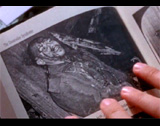
The Cropped WWI Photo of Wounded Jose Published in
Dr. Railly's Book
|
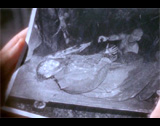
The Original Uncropped Photo on Dr. Railly's Bulletin Board
|
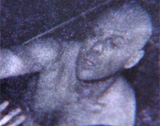
A Close-up of the Original Photo - Showing Cole in
the Image Reaching Out to Jose
|
- with Dr. Peters at his side in his laboratory, Dr.
Leland Goines assured Dr. Railly over the phone that his virology
lab was secure and that Jeffrey was not involved with a "monkey army"
to spread a virus: ("Neither my son nor any other unauthorized person has access to potentially
dangerous organisms in my laboratory"); Dr. Peters suggested that
the wildly-paranoid Dr. Railly had herself become afflicted: ("Has
she succumbed to her own theoretical Cassandra disease?")
- with scientists in 2035, Cole reviewed and memorized
the ordered sequence of worldwide cities where the unleashed virus
spread after its initial Philadelphia exposure on December 13, 1996
- it was followed by San Francisco, New Orleans, Rio de Janeiro,
Rome, Kinshasa, Karachi, Bangkok, and Peking; Cole was congratulated
for his sound memory by female scientist Jones (Carol Florence)
- Cole reappeared in late 1996 back in Philadelphia
where he found Dr. Railly spray-painting the side of the FAA building
with a red-lettered message asking: "Is There a Virus? Is This The
Source? 5,000,000,000 Die?"; Cole insisted
he was crazy, needed help, and wanted to turn himself in: ("I'm mentally
divergent. I know that now. And I want you to help me. I want to
get better"), but she led him away before he could be apprehended;
meanwhile, inside the FAA building, Goines insisted to Fale and a
few of his "Army" followers that 6 years earlier, he hadn't even
thought of leading the Army of the 12 Monkeys to conduct any crazy scheme
- Dr. Railly and Cole rented a dingy flophouse Globe
Hotel room for one hour, where the hotel desk clerk Charlie (Lee
Golden) insinuated Cole's intentions with his psychiatrist: "Whatever
gets it up for you, Jack"; in the room, Cole continued to insist:
"I am mentally ill. I imagined all these things, these people," but
now Dr. Railly had switched roles with him and began to suspect that his story about
a future virus plague was entirely believable; she directly asked: "You
had a bullet from World War I in your leg, James! How did it get
there?"), but when Cole claimed it might be another dream; she became increasingly
confused: "I can't believe that everything we say or do has already happened,
or we can't change what is going to happen, and, and if 5 billion
people are going to die, it's... "; Cole stressed: "I want this
to be the present. I want to stay here in this time with you"
- a bald, menacing figure named Wallace (Joseph McKenna)
barged into the room and assaulted Dr. Railly - "This is my territory,
bitch!" and punched her; Cole defended her by pummeling Wallace before
dragging him into the bathroom; Cole then emerged with a bloody knife
and his own two bloody molars in his hand: ("This is how they find
us. By our teeth. I don't want them to find me, ever. I don't want
to go back"); he was risking his life (and his existence in the future)
to be with her; they fled as cops surrounded the room with guns drawn,
and heard Wallace yelling: "I was attacked by a coked-up
whore and a, a f--kin' crazy dentist"
- the two escaped into downtown Philly - the exact location
where Cole in 2035 had seen a lion prowling on a building ledge;
Cole was also surprised by a life-sized stuffed bear in a display
window; from a payphone 20 yards away, Dr. Railly left a voice-mail
message to his superiors in 2035 warning about the Army of the 12
Monkeys headquartered in the FAA building on Second Avenue; to her
shock, Cole simultaneously recited for her the message that she had
just left: ("They played it for me. It was a bad recording, distorted.
I didn't recognize your voice")
- in a department store, Cole and Kathryn bought a tropical
hawaiian shirt and wigs for future use, to evade pursuit by the authorities
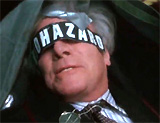
Jeffrey Goines With His Kidnapped and Blindfolded
Father in the Back of a Small Bus
|
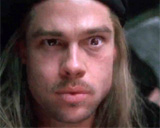
Dr. Goines to His Son: "Jeffrey, you're completely insane!"
|
- a group of activists in a small
white bus met up with Jeffrey Goines, who dumped a squirming bag
into the back of the bus; it held his kidnapped father Dr. Goines
with a BIOHAZARD strip of tape serving as a blindfold; Jeffrey asked:
"Wanna hear the monkey speak?" before opening the bag; Dr. Goines
insisted that he had taken precautions (due to warnings from Jeffrey's
psychiatrist) to prevent his son from carrying through on his "warped
little plan": ("I don't have the code anymore, Jeffrey. I don't
have access to the virus. I took myself out of the loop"); he also confirmed
that his son was crazy: "Now I know it's true. Jeffrey, you're completely insane"
- Dr. Railly and Cole donned
their disguises as they sat in a 24 hour movie theater watching a
24 hour marathon of four Hitchcock's movies throughout the night,
including Strangers
on a Train (1951), Vertigo
(1958), North
by Northwest (1959), and Psycho (1960);
an excerpted sequence from Vertigo was set in the California
redwoods where the protagonists, James Stewart and Kim Novak, spoke
about their life span, measured by ancient tree rings indicating
the passage of time from a 1930 cut-down tree; Cole wondered about
the nature of reality: "I think I've seen this movie before....It's
just like what's happening with us. Like the past. The movie never
changes. It can't change, but every time you see it, it seems different,
because you're different. You, you see different things"
- as the film played, Dr. Railly placed a glue-on
mustache onto his upper lip, explaining their most hopeful scenario in
a few weeks: "If there's still football games and traffic jams, TV
shows and armed robberies, we're going to be so glad that we'll be
thrilled to see the police"
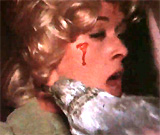
Bird Attack Scene in The Birds
|
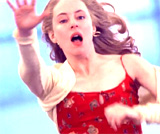
Kathryn Running in Airport
|
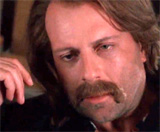
Cole Disguised With Mustache and Wig
|
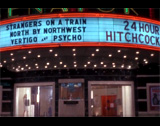
Marquee With 24 Hour Hitchcock Film Marathon
|
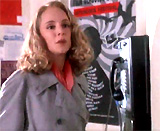
Kathryn at a Payphone in the Movie Lobby Making Travel
Reservations
|
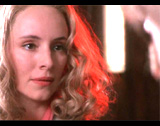
A Replay of the Transformation Scene in Vertigo
|
- at the Garden Zoological Society entrance (in Philadelphia),
the activists' bus was parked outside; a montage of images flashed
on the screen, including an excerpt from a 5th Hitchcock film The
Birds (1963) (the concluding attic bird attack scene in a
film with the theme of nature running amok), light-haired
Kathryn running in the airport, and Cole awakening wearing a mustache,
wig, and a tropical shirt; he found Dr. Railly hanging up the pay
phone in the movie lobby - she was wearing a platinum blonde hair
wig and a light-gray trenchcoat (like
the Hitchcock heroine Judy in Vertigo)
- she had made reservations
for them to fly together to a dream vacation
destination that same morning - the Florida Keys, before the virus
struck: ("We
have 9:30 reservations for Key West"); Cole recognized her from
his recurring dream: "It was always you. In my dream" - and
she responded similarly:
"I felt I've known you before. I feel I've always known you" [Note:
It was a replay of the central, visually-striking transformation
scene in Vertigo with the same theme music, when Judy
became Madeleine in Scotty's eyes.]
- as a pinkish dawn approached, the vandalistic pranksters freed
the wild animals from Philadelphia's Garden Zoological Society and
tied up traffic for the morning commute in the city; on the clogged
freeway, Kathryn's and Cole's Cabbie (Annie Golden) explained the
traffic jam was due to the "Twelve Monkeys" - "Bunch of weirdos let
all of the animals out of the zoo. Then they locked up this big-shot
scientist in one of the cages. Scientist's own kid one of the ones
did it. Now they got animals all over the place"; Dr. Railly and
Cole realized that Jeffrey Goines and his "Army
of the 12 Monkeys" were never the cause of the worldwide
plague that was released in mid-December 1996 - they were only vandalistic
pranksters with red spray-paint cans who emptied the zoo and had
nothing to do with the virus: "That's what they were up to, freeing
animals!"
- as they entered the Philadelphia airport, Cole recalled:
"I know this place....This is my dream...Not just my dream. I was
actually here. I remember now. About a week or two before the, before
everyone started dying...I was here - as a kid. I think you were
here then too"
- at the Philadelphia airport, Kathryn went to get
their tickets at the counter (using the name Judy Simmons from the
Hitchcock movie); in line behind her was a floor-level view of a
suitcase with stickers all over it - the yellow-coated, red-haired,
and pony-tailed individual checked in for a business trip to worldwide
destinations that followed the ordered sequence of cities (matching
what Cole had memorized); meanwhile, Cole was sending a phone message
to his contacts in the future - the scientists in the year 2035 -
to inform them that the "Army of the 12 Monkeys" was just
a red herring: ("The Army of The Twelve Monkeys are
just dumb kids playing revolutionaries"), and that he was quitting
his mission with them: ("I've done my job. I did what you wanted.
Good luck. I'm not coming back")
- Jose - Cole's time-traveling prison
cellmate appeared (he knew of Cole's whereabouts due to the recent
phone message) and gave Cole a WWI antique gun with firm instructions
to cooperate and heroically complete his mission by intercepting
the virus; Jose threatened to "shoot the lady" if Cole
didn't obey orders this time [Note: Cole's obedience
would preserve his own life's timeline and also ensure the release
of the virus. The scientists' specific goal was not to prevent the
pandemic-virus spread, since they couldn't alter the future, but to
find a cure after its spread!]
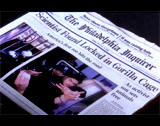
Philadelphia Inquirer Headlines About Zoo Release
|
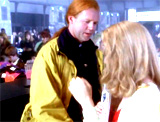
Kathryn Recognizing Dr. Peters at the Newspaper Stand
|
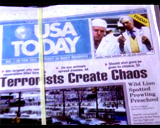
USA Today Headlines Regarding "Terrorists"
|
- at that same moment, Dr. Railly at the newspaper stand
- with the Philadelphia Inquirer reporting on the zoo release
- identified Dr. Peters (who worked in Dr. Goines' virology lab, and
presumably engineered the virus) after he bumped into her; after glancing
at the front page of a second paper, the USA
Today newspaper, she made the assumption that the "terrorists"
referred to in the headlines were Dr. Goines and Dr. Peters whose objective
was to unleash the doomsday virus as an act of terrorism; Kathryn ran
up to Cole to inform him that "apocalypse nut" Dr. Peters, Goines'
assistant, was involved in the virus conspiracy and boarding a plane
to San Francisco
- in front of them in the security
line, Dr. Peters was transporting a sticker-covered, carry-on suitcase
that contained biological live samples of the deadly virus; when
asked for them to be inspected, Dr. Peters claimed he had the proper
permission "papers"; the security agent ordered him to open one of
the vials, unwittingly infecting himself, the agent, and others around
them, as Peters assured him: "It looks empty; but I assure you, it's
not...All so invisible to the naked eye. It doesn't even have an odor"
- in the film's climactic ending (filmed in slow-motion), when
gun-brandishing Cole pursued the madman through security (after Dr.
Railly yelled out: "There he is! That man! He's carrying a deadly
virus. Stop him! Somebody, please stop him!"), Cole was fatally gunned
down from behind by airport police; madman Peters
got away and boarded his plane to San Francisco - with the goal of
infecting the world one city at a time
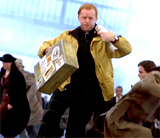
Madman Peters Racing Away From Security
|
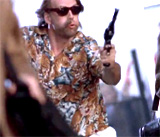
Cole in Pursuit With a Gun
|
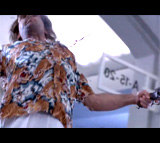
Cole Shot Dead by Security Police
|
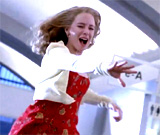
Kathryn Racing to His Side
|
- the film's main plot twist was revealed to clearly
explain the reason for Cole's repeated dreams and memories; during
Cole's sad, long drawn-out death after being shot in the Philadelphia
airport by security guards, he was mourned over by grieving Dr. Railly;
as she mourned above him, she scanned the many bystanders surrounding
them, and knowingly noticed young Cole nearby when their eyes made
contact; it was Cole as a young boy witnessing the shooting (and
his own death) in the far future; his attempts to prevent the future
led to his death in the future
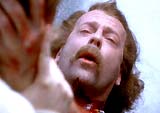
Dying James Cole Shot at Airport by Security Police
|
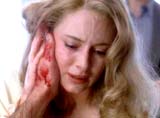
Comforted by Dr. Railly
|
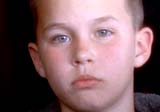
Cole (As Young Boy) Witnessing His Own Death
|
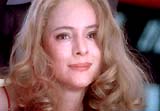
A Knowing Look Toward the Young Cole
|
- seated next to Dr. Peters (on a plane
eventually bound for Rome) was a woman who complained during a rant: "It's obscene, all the violence,
all the lunacy. Shootings even at airports
now. You might say that we're the next endangered species, human
beings"; Peters agreed with her: "I think you're right, ma'am.
I think you've hit the nail on the head"; she shook hands and
then introduced herself as Jones (Carol Florence): "I'm
in insurance"; she was one of the recognizable female astrophysicists
from the future who was guiding Cole's time travels; it was a hopeful
sign that she would bring back a pure sample of the virus
to the future to help save the extinction of the world with a cure
- the film concluded with a closeup of the eyes of young
Cole watching an off-screen plane take-off from the backseat window
of his parents' parked car in the airport lot; during the end credits,
performer Louis Armstrong sang: "What
A Wonderful World"
|

Opening Title Card
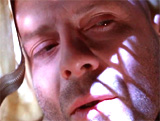
Underground Prison Inmate James "Jim" Cole
(Bruce Willis) Awakening From Recurring Nightmare
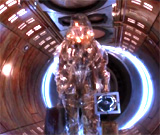
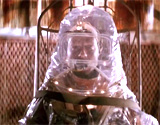
Cole - Selected (or "Volunteered") and Suited Up in a "Body
Condom" For A Probe Into the Desolate City of Philadelphia
in the Year 2035
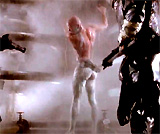
Cole Sanitized After Returning to the Underground World of 2035
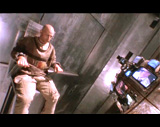
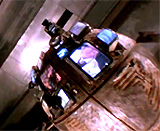
In an Elevated Chair, Cole Was Questioned by a Giant, Hovering "Video
Ball" With Multiple Screens (seen in close-up)
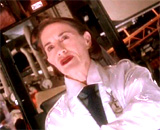
Cole Chosen For a Time-Travel Mission Back to the Past (Female
Scientist: "We
want tough-minded people")
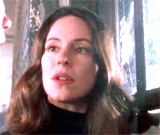
In 1990, Baltimore Psychiatrist Dr. Kathryn Railly (Madeleine
Stowe)
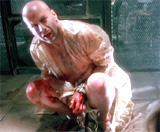
James Cole Arrested and In the Baltimore County Jail in 1990
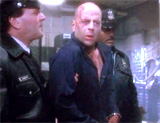
Cole Being Transported From the County Jail to the Baltimore County Hospital
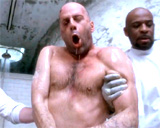
Cole Admitted to the Baltimore County Hospital
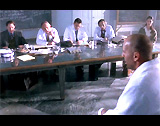
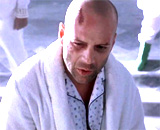
Before a Panel of Psychiatrists in the Baltimore County Mental Hospital
in 1990
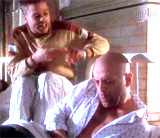
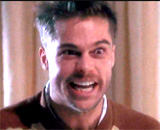
Ranting and Raving Psychotic Goines' "Germs" Conspiracy
Speech to Cole
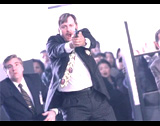
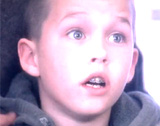
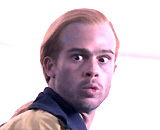
Third Instance of Cole's Dream of an Airport Shooting Involving a
Suitcase-Carrying Suspect with a Yellow Jacket
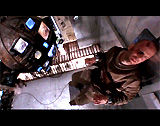
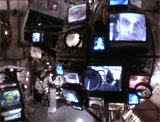
Cole Returned to the Year 2035 After Being Misdirected to the Year
1990 in Baltimore - More Questions Before Scientists and the "Video
Ball"
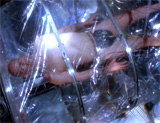
Cole's Second Chance at Time-Travel Back to 1996
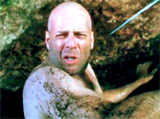
Misdirected - Cole Was Nearly Naked in the French Trenches of WWI - in
late 1917
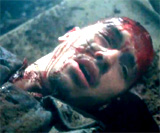
Wounded Jose on a Stretcher ("I gotta find him...")
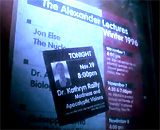
November 1996, in Baltimore
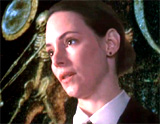
Lecture: "Apocalyptic Visions" by Dr. Railly
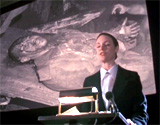
Wounded Soldier (Jose) in WWI Shown During Dr. Railly's
Lecture-Slide Show
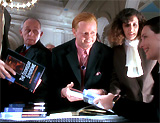
Dr. Peters at The Doomsday Syndrome Book-Signing
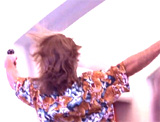
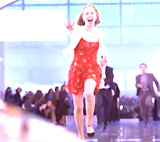
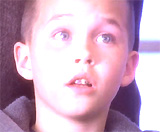
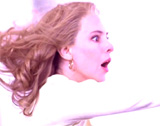
Fourth Instance of Dream-Memory
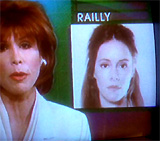
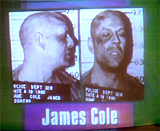
Newscast about Dr. Railly's Kidnapping by James Cole
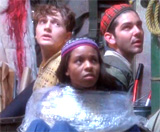
Three FAA Members (l to r): Bee, Teddy, Fale
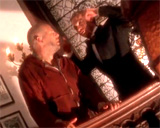
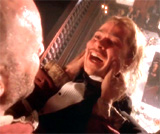
The Crazed Goines Accusing Cole of Being a Nutcase in His Father's
Luxurious Home
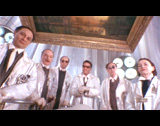
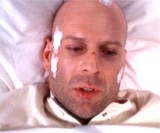
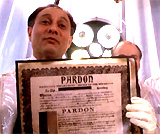
Cole Returned to 2035, Hospitalized, and Told He Was Pardoned After
Completing His Mission
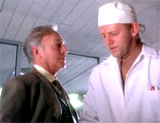
Dr. Leland Goines and Dr. Peters in Goines' Virology Laboratory
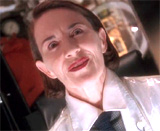
Scientist Jones Congratulating Cole For His Great Memory
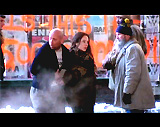
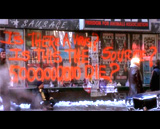
Dr. Railly Spray-Painting the FAA Building and Leading Cole Away
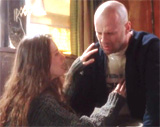
In the Globe Hotel in Philly, Dr. Railly Attempted to Understand Cole's
Delusions-Dreams
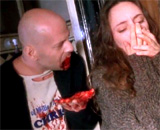
Cole With His Own Two Bloody Molars in His Hand
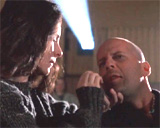
In the Movie Theatre, Dr. Railly and Cole Watched Hitchcock Movies
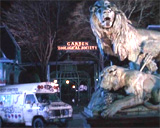
Entrance to Philadelphia Zoological Society
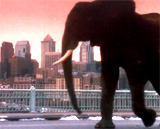
Animals Freed at Dawn From the Philly Zoo
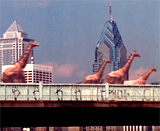
Giraffes Running Wild
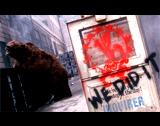
The Army of the 12 Monkeys' Admission: "We Did
It" -
Release of Animals From the City's Zoo
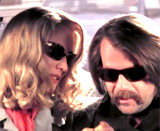
The Cab Trip to the Philadelphia Airport For the Disguised Kathryn
and Cole
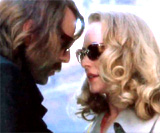
In the Airport, Cole Recalled Being There Before
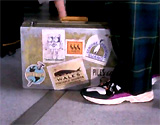
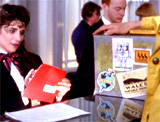
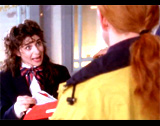
At the Counter, Dr. Peters Checking In With The Sticker-Covered Suitcase
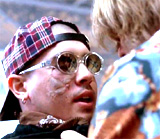
Cole Confronted by Jose - Who Passed a Gun To Him
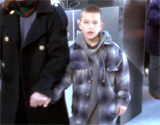
A Young Boy James Passed Through Security
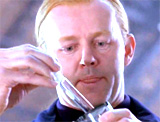
Dr. Peters With the Opened Vial of the Live Virus Biological Sample
at the Airport - Spreading the Deadly Plague
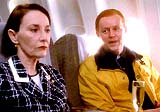
Dr. Peters on Plane Next to Female Scientist "Jones" (Carol
Florence) From 2035
|





























































